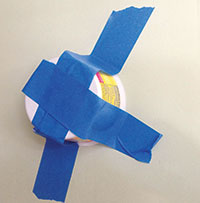
Arachnophobia (the fear of spiders) can be intense, as witnessed by this plastic container taped to the wall: “I don’t want to hurt him, I just don’t want him in my house!” Photo: Kate McGovern
Reading the mainstream media’s headlines, one would think the No. 1 feared pest is bed bugs. Ask a psychologist or a pest management professional (PMP), though, and the answer is spiders.
Hands down, people of all genders, ages and cultures name spiders as their worst nightmare. Sadly, people have lost homes and property trying to kill spiders with handguns, sledgehammers and blowtorches. Fortunately for PMPs, most will trust the pros to manage the problem for them.
Spiders are largely beneficial as voracious predators of insects. Humans are largely accommodating with their interior and exterior architecture and accumulations of stuff, attracting a smorgasbord of insects for the eager arachnids.
Insecticides labeled for spiders will kill on contact, but the residual might not. Because spiders spend most of their lives with their bodies high above surfaces, with only their tiny feet making contact, the product doesn’t reach the body unless the spider is in a treated crack or crevice. Control lies in managing or eliminating the food resources, and persistently discouraging web building with removal.
With that in mind, come along with us on a typical spider call.
Start a conversation
The first step when arriving on the scene was a brief conversation with the homeowners to get a sense of how they felt about spiders. It might sound silly, because the assumption is that they just want the spiders gone, period, but you might find that some customers do see the benefits of spiders and want them gone, but not necessarily dead. For example, some homeowners might even have a spider they’ve singled out, become accustomed to and named, living in the corner of a room.
Step inside
After getting our bearings, we focused on the interior:
1. A vacuum and a web-removal brush were used to remove all webs.
2. Windowsills and frames were vacuumed and received crack-and-crevice treatment with a product labeled for indoor use on spiders. Keep in mind that using a product labeled for spiders doesn’t necessarily mean using high-toxic products. There are 25(b) exempt, commercially available products composed of vinegar and essential oils that dissolve webs and irritate the feet and legs of spiders. This repels them from the targeted area. These products can still kill on contact, however, so be careful if you’re trying to preserve Fred the Daddy Longlegs in the corner on the customer’s behalf.
3. Next, plumbing cabinets and pipe areas were checked, and sticky traps and glue boards placed. Inside closets, between walls and furniture, and around other dark, undisturbed areas are all appropriate areas for glue and sticky trap placements.
4. The homeowner was instructed to remove clutter and debris to reduce insect harborage.
5. Lamp placements near windows were checked to reduce or remove nighttime flying insect activity.
Let’s Step outside
Next, the interior process was adapted for the great outdoors:
1. A vacuum and web-removal brush were used to remove all visible webs from the structure, around door and window frames, weep holes, outdoor furniture, air-conditioning units, vents, mailboxes, hollow pipes and tubing.
2. Cracks and crevices were treated with a product labeled for outdoor use on spiders.
3. Glue boards were used on either side of garage doors and basement entryways to stop infiltration.
4. The homeowners were instructed to remove clutter and debris away from the structure, and keep shrubbery and landscape plantings to a minimum and away from the building. They were told to also inspect plants, firewood and other outdoor items before bringing them inside, especially if there’s a weather change. This can be done for them as an add-on service.
5. Lighting placement is key. Exterior lights were mounted away from the building. In addition, motion detectors can be used to reduce nighttime insect activity.
6. Crawlspaces and areas prone to moisture accumulation will be checked regularly.
Payment, please
How to charge? The answer lies in your business model and what makes sense to you and your clients. Some include it as part of routine interior/exterior service. Some include it in the initial service, but as an additional upcharge thereafter.
A spider call can be used as a selling tool for exclusion work. As your confidence in the quality of your work increases, consider offering a guarantee.
You can reach Jeff and Kate McGovern at jeffreymcgovern@mindspring.com.



Good presentation, focused on housekeeping, which is the only surefire way to control spiders; notice I did not say eliminate.